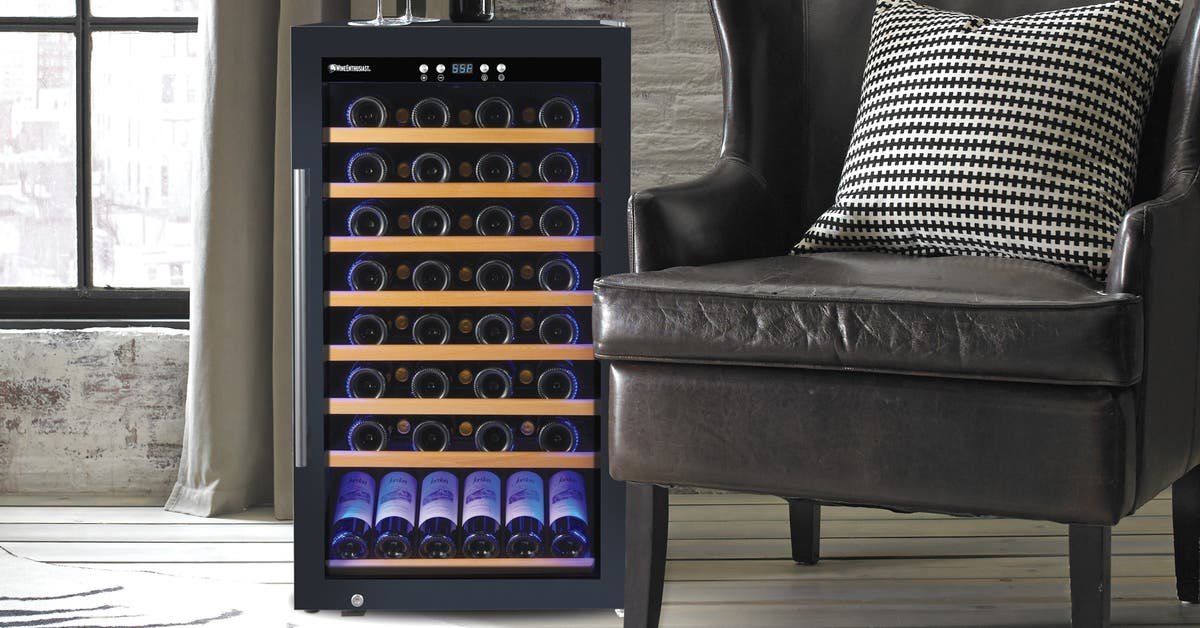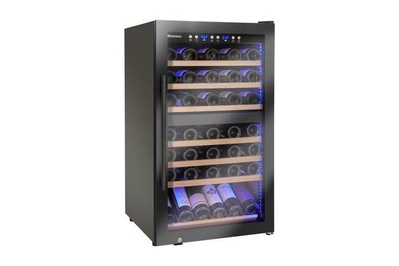
Best for…

Not everyone wants a dual-zone fridge, but this model will keep your reds and whites ready to drink at the right temperature. However, it sacrifices some storage space.
Among the hundreds of wine fridges we considered, the Wine Enthusiast Classic 80 Wine Cellar has the best capacity and features for the price. This model is the best choice if you’re just getting into wine collecting but you want a fridge that lasts, or if you want to maximize storage space. The Classic 80 should hold about five to six cases of wine, and it is about the size of a large end table. After reading thousands of reviews on hundreds of models, we don’t think a perfect budget-friendly wine fridge exists. The Classic 80 is basic, but it’s made by a trusted company within the wine industry. Unlike big-box appliance stores, Wine Enthusiast sells only wine fridges, furniture, and accessories.
Multiple experts recommended the Wine Enthusiast fridges, including Ashley Santoro, Lydia Richards, Michele Thomas, and Eric Asimov, as do publications like The Strategist and Epicurious. The retail arm exists under the same umbrella company as Wine Enthusiast magazine, but the two are separate entities. A representative from the company told us the magazine does not write reviews of wine refrigerators because that would be a conflict of interest; Wine Enthusiast does sometimes cover the brand’s own furniture and accessories. Wine Enthusiast has been making fridges (and selling wine accessories) since 1982.
The Classic 80 is a single-zone fridge. This means all of the wine you store in it will be kept at one temperature. You can choose to set the temperature between 41 °F and 68 °F (the recommended ambient operating temperature is 61 °F to 90 °F, though your fridge will have to work harder to stay cold in hotter climates). Most of the experts we spoke with didn’t consider dual temperature zones to be a must-have feature. If you aren’t concerned about dedicated aging, sommelier Michele Thomas told us that most wines should be fine stored at about 50 °F.
Single-zone fridges such as the Classic 80 will provide more space and flexibility for the types of bottles you store, since there isn’t a divider shelf between two compartments. Ashley Santoro, owner of Leisir wine store in New York City at the time of our interview, recommends a single-zone fridge for people living with space constraints.
Single-zone fridges are also more likely to maintain consistent temperatures—key for protecting wine from seepage or oxidation—and they last longer. Some expensive dual-zone fridges have separate compressors for each compartment, but most circulate air from one compressor between the sections with a fan. In our research, we learned that wine fridges commonly fail because the compressor (the part that keeps a fridge cool) dies relatively quickly. And in a dual-zone fridge, the compressor has to work harder to maintain two different temperatures, so it may wear out faster. Steve Johnson, an owner of Mr. Appliance repair franchises, told us that with dual zones, “As one cycles off, the other cycles back on, so it makes the compressor run longer.” Lydia Richards, sommelier and founder of Vino Concierge, said, “In my opinion, dual zones are not necessarily important. The main consideration is consistency in temperature.” To bring your wine to drinking temperature before serving, you can simply pull out a bottle to warm it up (conversely, you can give wines that need it an extra chill by popping them into the fridge for 10 to 15 minutes). But if you want to be able to pull out a bottle that’s ready to pour, you might want to consider our best dual-zone pick, the Classic 70.
Since you’ll likely need more storage than you anticipate, we think this medium-size fridge will work for most beginner to mid-level collectors. Most wine fridges hold fewer bottles than they advertise, especially if you buy larger California reds, taller rieslings, or bulbous magnums. You can store larger or differently shaped bottles in the Classic 80’s angled bottom display shelf (the slight angle should keep the wine in contact with the cork). Reviewers also report that if you need extra space, you can stack multiple bottles at the bottom of the fridge, and you can also remove a shelf for bulk storage.
Most of the fridges we looked at had digital touchscreen controls to set the temperature, and the Classic 80 is no different. This fridge also has blue LED lights (which don’t emit enough UV light to harm wine) throughout, so you can see your selection (and you can turn them on and off). The door to this fridge has three layers of glass, for extra insulation and efficiency, and it has a tinted coating to help guard against UV rays. Though glass will allow you to see your bottles better, a solid door is best for protecting wine from light. (Our upgrade pick offers that option.) The door on the Classic 80 has a handle on the right side.
Like the aesthetics of most fridges we considered, the Classic 80’s aesthetics are straightforward. Some step-above fridges have stainless steel frames and all-wood shelves. But we think the Classic 80’s shelves—with their streamlined black finish and wood trim—look nice enough that you’ll want to keep this fridge in your home, instead of banishing it to the garage.

Unlike some other basic fridges we looked at, the Classic 80 has sliding shelves, so you can easily add or retrieve wines. They are powder-coated stainless steel with rounded wires, instead of slats, and with elegant-looking wood trim facing the door. Higher-end fridges have all-wood shelves, with cradles for individual bottles; these help absorb vibrations, prevent bottles from rolling around, and generally look nicer. But we should note that the bottom display rack on the Classic 80 is all wood.
The Classic 80 also comes with a lock, just in case you want one. We didn’t notice significant noise complaints for this fridge; in fact many reviewers praised it for its silence. Online reviews for many other models we considered noted they were obnoxiously loud.
The Wine Enthusiast Classic line, which is entry-level compared with the brand’s other offerings, also includes larger, 150- and 200-bottle single-zone options. Wine Enthusiast makes smaller, no-frills fridges, as well as upgraded or larger fridges with dual zones, larger capacities, and more features. Some of these can also be built into cabinets, whereas the Classic fridges are freestanding.
It’s crucial to buy a fridge that comes with a good warranty and customer service. Sometimes fridges can arrive damaged or need replacement parts. They may also be too heavy for you to move into your home on your own. The Classic line has a one-year warranty, with a three-year warranty on the sealed system parts (warranties vary based on the line).
Other appliance companies offer varying levels of customer support to help you shop for a fridge, but Wine Enthusiast has a knowledgeable team that specializes in one thing—wine fridges. We spoke with Marshall Tilden III, vice president of sales and wine education at Wine Enthusiast and contributing editor to the magazine at the time of our interview, about the company’s customer service. Team members will help you choose the best option for your needs and space, to try to preempt any need for a return. They can also coordinate delivery and installation if needed. Tilden told us Wine Enthusiast offers free unlimited phone consultations while you’re shopping for a fridge, and it will even look over construction plans, if you’re building in a fridge. (AJ Madison and Best Buy offered comparable consultations.)
You can also opt to pay extra for in-home delivery service, so the fridge will be delivered not only to your door but also to where you want it in your house. (You may have to pay extra if the delivery people need to go beyond a set number of stairs or for assembly. But aside from installation of the handle, our picks are ready to go.) This service can be helpful because a wine fridge is an unwieldy appliance. Members of the forum Wine Berserkers also recommend Costco’s service and delivery, and the retailer offers several Wine Enthusiast fridges (but not our picks, at the time of writing). Wine Enthusiast also has a showroom in Valhalla, New York.
Reviewers note that the Classic 80 is “impressively quiet” and “the temperature holds quite well.” Most acknowledge that it holds fewer than 80 bottles, which is to be expected. Though editorial reviews we read generally recommend the Wine Enthusiast brand, they don’t describe any testing. The experts we spoke with also had generally good things to say. “Wine Enthusiast has a nice line that’s easy going, small, and pretty quiet (for compressor models),” said Michele Thomas. Vino Concierge’s Richards told us that she received a small Wine Enthusiast fridge as a gift long ago, and it “stays consistent in terms of temperature control.”
Flaws but not dealbreakers
This is a standalone wine fridge, so you can’t build it into cabinets. That said, Wine Enthusiast sells other models that can be built in. The Classic 80 also has a rear vent, so you’ll need to install this model in a place where there’s ample ventilation space around the fridge (not right up against a wall).
All wine fridges hold less than what they say they will, and the Classic 80 is no different. Tilden told us that certain pricier Wine Enthusiast fridges have shelves with more space to fit larger bottles.
Technically, you can reverse the handle on the Classic 80, but you will lose the lock function because you essentially will have to turn the door upside down.
There are nearly 150 reviews for this fridge (mostly positive). People on forums like Wine Berserkers and Reddit don’t have much to say about the line (the ones on Wine Berserkers seem to be more-serious collectors, and so they tend to discuss larger, higher-end fridges and alternative storage options, like luxury cabinets, cellars, or offsite storage).





